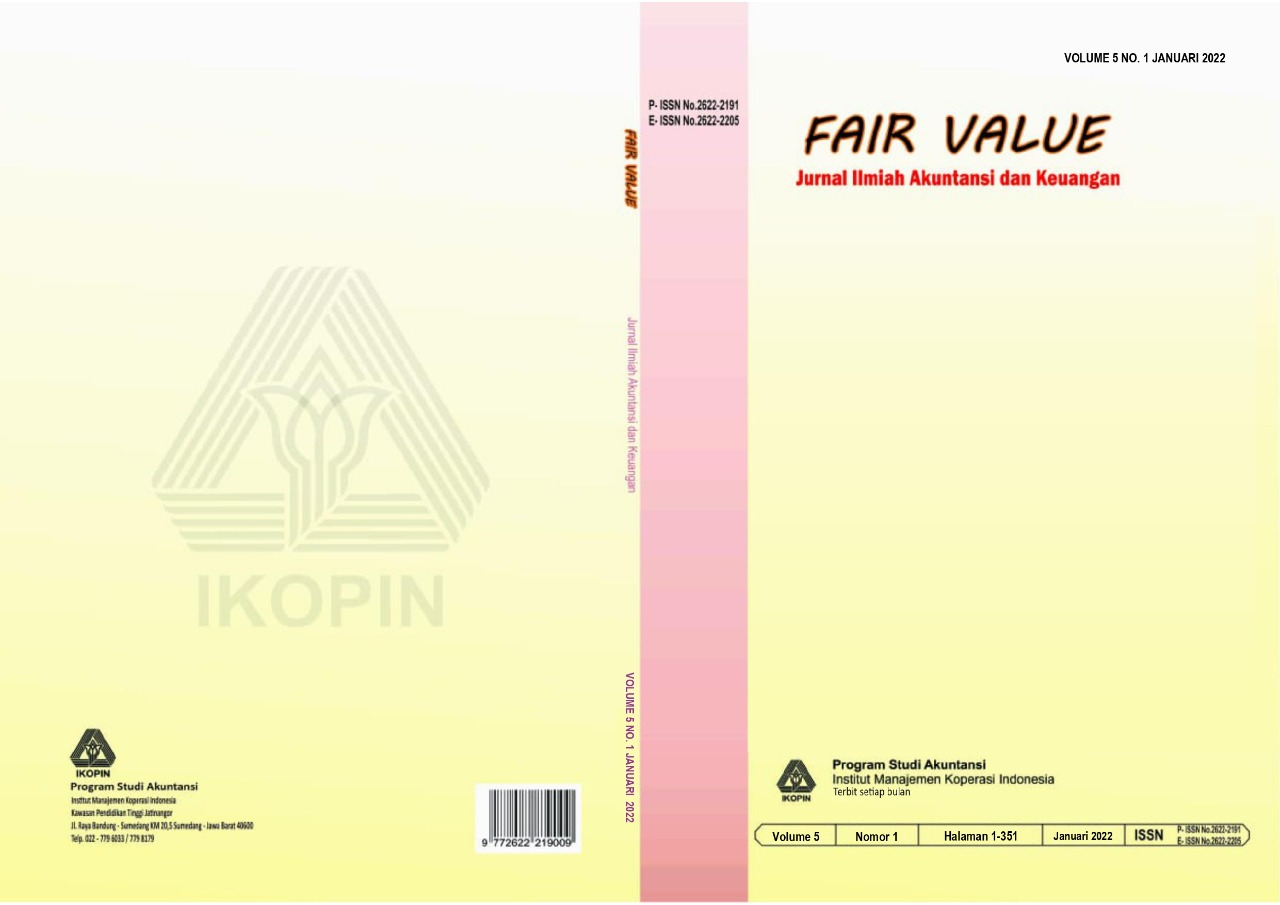Manajemen laba model jones dimodifikasi dan arus kas operasi terhadap keputusan investasi pada sektor aneka industri di BEI setelah implementasi IFRS
Main Article Content
Abstract
The purpose of this examination was to the benefits of accounting information in the form of earnings management and operating cash flow on investment decisions. One of the benchmarks in the consideration of investment decisions is the value of the enterprise which can be seen in its share price. The category of research used is quantitative using secondary data in the form of pool data. Companies used as research objects are in the different industrial sectors listed on the IDX after the implementation of IFRS. The data needed are financial statement data and company stock price data by using research is multiple linear regression. After testing the hypothesis, it shows that earnings management has no effect on the company's stock price, but operating cash flow affects the company's stock price. It shows that the financial statement information is useful for investors. This research suggests that further research should use companies whose data variance is not too high and classify companies that have positive and negative earnings management values so that results can be more informative in making an investment determination.
Article Details
References
Ahlers, G. K. C., Cumming, D., Günther, C., & Schweizer, D. (2015). Signaling in equity
crowdfunding. Entrepreneurship Theory and Practice, 39(4), 955–980.
Badolato, P. G., Donelson, D. C., & Ege, M. (2014). Audit committee financial expertise and earnings
management: The role of status. Journal of Accounting and Economics, 58(2–3), 208–230.
Beslic, I., Beslic, D., Jaksic, D., & Andric, M. (2015). Testing the models for detection of earnings
management. Industrija, 43(3), 55–79. https://doi.org/10.5937/industrija43-8035
Britt, J. H., Cushman, R. A., Dechow, C. D., Dobson, H., Humblot, P., Hutjens, M. F., Jones, G. A.,
Ruegg, P. S., Sheldon, I. M., & Stevenson, J. S. (2018). Invited review: Learning from the future—
A vision for dairy farms and cows in 2067. Journal of Dairy Science, 101(5), 3722–3741.
Cao, Y., Myers, L. A., Tsang, A., & Yang, Y. G. (2017). Management forecasts and the cost of equity
capital: international evidence. Review of Accounting Studies, 22(2), 791–838.
Collins, D. W., Hribar, P., & Tian, X. (2014). Cash flow asymmetry: Causes and implications for
conditional conservatism research. Journal of Accounting and Economics, 58(2–3), 173–200.
https://doi.org/10.1016/j.jacceco.2014.08.010
Dang, N. H., Hoang, T. V. H., & Tran, M. D. (2017). Factors affecting earnings management: The case
of listed firms in Vietnam. International Journal of Economic Research, 14(20), 117–134.
Darwis, H. (2012). Manajemen laba terhadap nilai perusahaan dengan corporate governance sebagai
pemoderasi. Jurnal Keuangan Dan Perbankan, 16(1).
Gill, A., Biger, N., Mand, H. S., & Mathur, N. (2013). A5 2 _ 11 EM with Firm Performance - Earnings
Management. International Research Journal of Finance and Economics, DECEMBER.
Gujarati, D. N. (2009). Basic Econometrics Fifth Edition. McGraw-Hill.
Indriani, A. D., & Pujiono, P. (2021). Analysis of earnings management practices using the modified
jones model on the industry company index kompas 100. 11(1), 235–243.
https://doi.org/10.14414/tiar.v11i2.2383
Jensen, M. C., & Meckling, W. H. (2019). Theory of the firm: Managerial behavior, agency costs and
ownership structure. In Corporate Governance (pp. 77–132). Gower.
Jintaviwatwong, B., & Suntraruk, P. (2013). The informativeness of earnings ad operating cash flows:
empirical evidence from the stock exchange of Thailand. Journal of Business Administration The
Association of Private Higher Education Institutions of Thailand, 2(1), 75–83.
Jiraporn, P., Miller, G. A., Yoon, S. S., & Kim, Y. S. (2008). Is earnings management opportunistic or
beneficial? An agency theory perspective. International Review of Financial Analysis, 17(3), 622–
https://doi.org/10.1016/j.irfa.2006.10.005
Kieso, D. E., Weygandt, J. J., & Warfield, T. D. (2018). Akuntansi Keuangan Menengah; Intermediate
Accounting.
Kipngetich, S. Ben, Tenai, J., & Kimwolo, A. (2021). Effect of Operating Cash Flow on Stock Return
of Firms Listed In Nairobi Security Exchange. Eastern Journal of Economics and Finance, 6(1),
–35. https://doi.org/10.20448/809.6.1.26.35
Oktari, M. M., & Sunarsih, U. (2020). The Influence of Earnings, Operating Cash Flows, Firm Size and
Leverage Stock Price. Sekolah Tinggi Ilmu Ekonomi Indonesia, 1–21.
Perdamenta, H. (2016). Laba akuntansi dan arus kas operasi terhadap perubahan harga saham pada
perusahaan otomotif yang terdaftar di bursa efek indonesia (Bei). Jurnal Akuntansi Dan Bisnis,
(2), 36–45.
Scholtens, B., & Kang, F. (2013). Corporate social responsibility and earnings management: Evidence
from Asian economies. Corporate Social Responsibility and Environmental Management, 20(2),
–112.
Sitorus, J. S., Siburian, E., Simbolon, Y., & Naibaho, R. E. br. (2021). the Effect of Operating Cash
Flow, Net Profit, Roa and Roe on Stock Return of Idx. Jurnal Akuntansi, 11(2), 189–196.
https://doi.org/10.33369/j.akuntansi.11.2.189-196
Tangjitprom, N. (2013). The Role of Corporate Governance in Reducing the Negative Effect of
Earnings Management. International Journal of Economics and Finance, 5(3), 213–220.
https://doi.org/10.5539/ijef.v5n3p213
Wooldridge, J. M. (2015). Introductory econometrics: A modern approach. Cengage learning.

